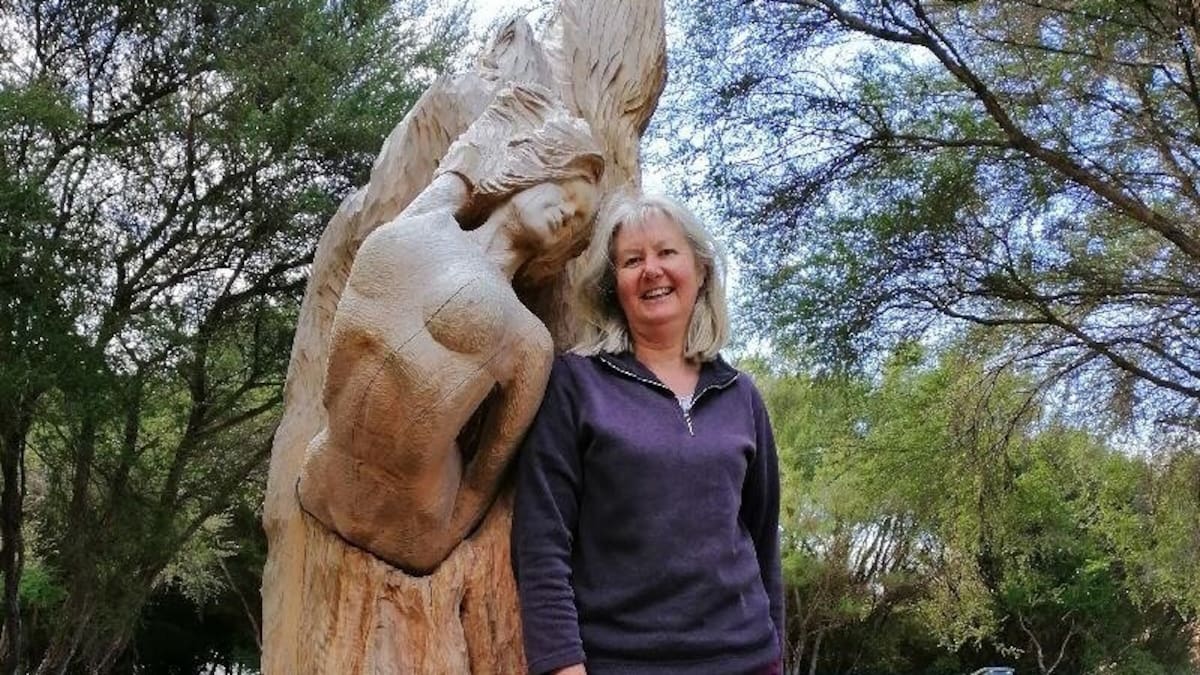Geyser was named the symposium’s People’s Choice winner and became a permanent part of the Sulphur Lake Sculpture Trail in Rotorua’s Government Gardens.
When it was found in a Rotorua resident’s garden last Friday, daubed with lipstick and coloured hair, the homeowner posted photos to a community Facebook page asking if anyone recognised it.
Former Rotorua Lakes Council community arts adviser and public art expert Marc Spijkerbosch recognised it immediately. A regular Sculpture Trail walker, he had noticed months ago that the piece was missing.
Once “supple” and “gorgeous”, it was now “ghastly”, he said. He called the damage “horrible” and “disrespectful” and described it as “quite a spooky-looking thing to find in the garden”.
Geyser, a work by Northland artist Susan Dinkelacker, went missing from Rotorua’s Sulphur Lake Sculpture Trail and was found dumped and vandalised in a resident’s garden.
For Dinkelacker, who balances her art with flying the air ambulance in Northland, seeing her work in such a state was “awful”.
She specialises in wood sculptures, and rarely depicts the human form, saying she preferred birds, which were less “fraught” as public artworks.
“In a way, Geyser has proven that, as she was stolen and painted,” Dinkelacker said.
The piece had been “an absolute pleasure” to create, and she described it as a highlight of her career.
Geyser was created during 10 days of carving at the 2018 Rotorua Sculpture Symposium, relating to the theme Ngā Wai o Rotorua (the waters of Rotorua).
Dinkelacker recalled working on it during a rare moment of “flow” when everything came together effortlessly.
But restoring it, she said, would be nearly impossible.
Tōtara left outdoors takes on a silvery patina as it weathers, so scraping away the paint would expose raw wood beneath, leaving the surface uneven and patchy.
“You would have to rework the whole thing, which defeats the purpose,” she said.
Susan Dinkelacker carved Geyser from tōtara during the 2018 Rotorua Sculpture Symposium.
Once valued at $8000, the sculpture was now “basically worthless”. She said it might be better to “destroy it”, but she would assess this when the sculpture was back in her possession.
She took some comfort in the fact that the work had already served its purpose by inspiring and delighting those who saw it.
For years, visitors, including Dinkelacker’s family and friends, had travelled to Rotorua to view her sculpture.
She hoped it would be remembered as “inspiring and positive”, not for the way it ended.
Rotorua Lakes Council confirmed the sculpture had been missing “for a few weeks” and was initially thought to have been collected by the artist as part of a trail refresh.
Council staff had collected the sculpture, which was in storage until Dinkelacker could collect it, a spokesperson said.
The theft had not been reported to police.
The spokesperson said any damage or vandalism was “extremely disappointing”.
“Our city’s public art collection celebrates Te Arawa, our people and our history, and is here for everyone to enjoy and respect.”
It’s not the first time public art in Rotorua has been targeted.
Last year, the bronze sculpture of beloved stray dog Harawene was sawn off – though it was later remade and returned to its Te Ngae Rd perch.
In 2023, the bronze bust of tourism pioneer Camille Malfroy was stolen from Government Gardens and later recovered, though damaged.
Annabel Reid is a multimedia journalist for the Bay of Plenty Times and Rotorua Daily Post, based in Rotorua. Originally from Hawke’s Bay, she has a Bachelor of Communications from the University of Canterbury.

